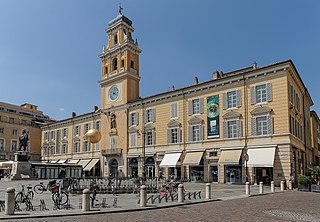
Parma is a city in the northern Italian region of Emilia-Romagna known for its architecture, music, art, prosciutto (ham), cheese and surrounding countryside. With a population of 198,292 inhabitants, Parma is the second most populous city in Emilia-Romagna after Bologna, the region's capital. The city is home to the University of Parma, one of the oldest universities in the world. Parma is divided into two parts by the stream of the same name. The district on the west side of the river is Oltretorrente. Parma's Etruscan name was adapted by Romans to describe the round shield called Parma.
Sala or SALA may refer to:

The Villa Farnese, also known as Villa Caprarola, is a pentagonal mansion in the town of Caprarola in the province of Viterbo, Northern Lazio, Italy, approximately 50 kilometres (31 mi) north-west of Rome, originally commissioned and owned by the House of Farnese. A property of the Republic of Italy, Villa Farnese is run by the Polo Museale del Lazio. This villa is not to be confused with two similarly-named properties of the family, the Palazzo Farnese and the Villa Farnesina, both in Rome.

Fontanellato is a small town in the province of Parma, in northern Italy. It lies on the plains of the River Po near the A1 autostrada, about 20 kilometres (12 mi) west of Parma towards Piacenza.

The Rocca Sanvitale, or Sanvitale Castle, is a fortress residence in the centre of the town of Fontanellato, near Parma, northern Italy. Construction of the moated block, accessible through a drawbridge, was begun in the 13th century, mostly completed by the 15th century, with embellishments continuing through to the 18th century. It is prototypical of the urban castle-houses of the turbulent medieval communes of Northern Italy. Until the 1930s it was the home of the descendants of the Count of Sanvitale.

Colorno is a comune (municipality) in the Province of Parma in the Italian region Emilia-Romagna, located about 90 kilometres (56 mi) northwest of Bologna and about 15 kilometres (9 mi) north of Parma.

Sala Baganza is a comune (municipality) in the Province of Parma in the Italian region Emilia-Romagna, located about 90 kilometres (56 mi) northwest of Bologna and about 12 kilometres (7 mi) southwest of Parma.

The Ducal Palace, also known as Reggia di Colorno, is an edifice in the territory of Colorno, Emilia Romagna, Italy. The palace we see today was refurbished by Francesco Farnese, Duke of Parma in the early 18th century on the remains of a former castle.

The Shrine of Santa Maria della Steccata is a Greek-cross design Renaissance church in central Parma, Italy. The name derives from the fence in the church. A Nursing Madonna is enshrined within, crowned on 27 May 1601 by a Marian devotee, Fray Giacomo di Forli of the Capuchin order. Pope Benedict XVI raised the Marian sanctuary to the status of Basilica minor on 9 February 2008.
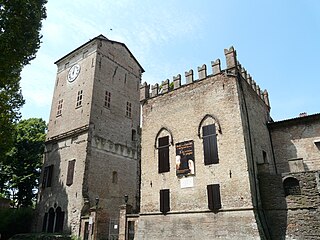
Rocca dei Rossi is a castle located at piazza Mazzini #12 in the town of San Secondo Parmense, province of Parma, in the Italian region Emilia-Romagna. A different Rocca dei Rossi, also known as Castello di Roccabianca, is located in the town of Roccabianca.

The Val di Taro is the valley of the Taro river, a tributary of the Po. The valley lies almost entirely in the Province of Parma, in the Emilia-Romagna region of Italy.
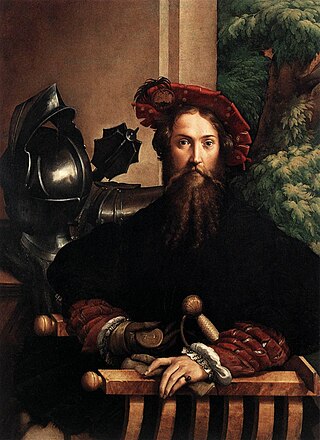
Portrait of Galeazzo Sanvitale (1524) is a painting of the condottiero Gian Galeazzo Sanvitale by the Italian late Renaissance artist Parmigianino. It is housed in the National Museum of Capodimonte, Naples, Italy.

Gian Galeazzo Sanvitale, also known as Galeazzo I Sanvitale was an Italian condottiero, a member of the noble Sanvitale family.
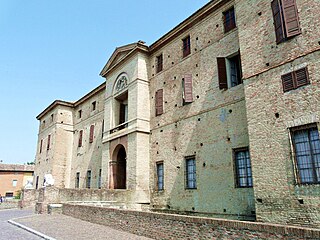
The Rocca Meli Lupi, also called Rocca di Soragna, is a castle-palace located in the town of Soragna, Province of Parma, region of Emilia-Romagna, northern Italy. It has a rough, unfinished exteriors and highly decorated interior rooms.
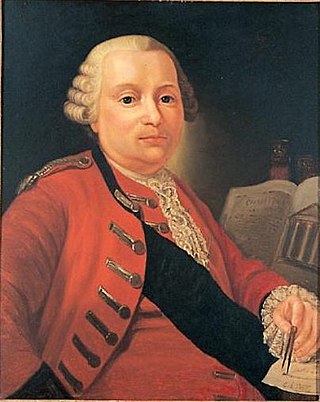
Ennemond Alexandre Petitot (1727-1801) was a French-born architect, mainly active in the Duchy of Parma.

The Palazzo di Riserva, also known as the Palazzo delle Poste because for long it hosted the offices of the Postal Service, is a Neoclassical-style palace in central Parma, region of Emilia Romagna, Italy. The large structure now hosts the Museo Glauco Lombardi displaying collections from 19th-century Parma, as well as offices of the postal service, the provincial forestry service, a literary club, and several shops. It has been much altered over the years.
Sanvitale is an Italian surname. It may refer to:

The Palazzo del Giardino or Palazzo Ducale del Giardino is a historic palace in the Parco Ducale in Parma. It is not to be confused with the official Parma residence of Marie Louise, Duchess of Parma between Palazzo della Pilotta and Palazzo della Provincia in what is now known as piazzale della Pace - she also lived at the Ducal Palace of Colorno and in the Casino dei Boschi in Sala Baganza. The main Ducal Palace in Parma, the Palazzo della Pilotta and the Reinach Theater were all destroyed in an early morning air raid on 13 May 1944, carried out by the 465th Heavy Bombardment Group of the US Airforce, 781st Squadron, which dropped 9 GP bombs on the city centre.
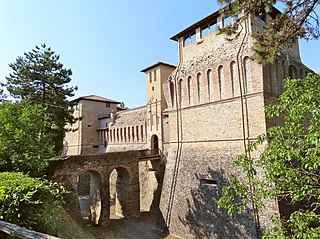
The Castello or Castle of Felino is a moated castle in a forested grove near the town of Felino, province of Parma, region of Emilia Romagna, Italy.

The Ducal Palace of Parma was a neoclassical palace in Parma, Italy. It was located on the west side of the Piazzale della Pace. Between its construction and 1859, it was the residence of the Dukes of Parma. After 1859, it became the prefecture.



















